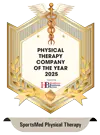February is American Heart Month and the perfect time to show yourself some love by taking care of your ticker.

First, it’s important to know the facts:
- Heart disease is the leading cause of death in the United States, accounting for 1 out of every 4.
- The term “heart disease” actually refers to several conditions, the most common of which is coronary artery disease (CAD).
- While there are risk factors for heart disease that may not be in our control, in most cases, it’s preventable with lifestyle modifications. High blood pressure, high cholesterol, and diabetes are correlated with heart disease, but so are smoking, excessive alcohol use, high stress levels, being overweight or obese, eating an unhealthy diet, and lack of physical activity.
Adopting healthy lifestyle choices can be overwhelming, so it can be helpful to focus on one healthy habit at a time. (Often once you start to experience the benefits, you may find yourself motivated to take on more changes!)
At SportsMed Physical Therapy, we are experts in the human body and its performance, so naturally, we’ll focus on physical activity. In this article, we’ll discuss the benefits of exercise in relation to heart health and reducing the risk of heart disease and related conditions.

Physical activity of all kinds has a wide variety of positive effects on both mind and body, from improved cognition to better balance. In terms of heart health, cardiovascular fitness is important when it comes to improving risk factors for heart disease, many of which your doctor may test through blood work. These exercise-induced benefits include:
- Lowering blood pressure
- Lowering LDL (“bad”) cholesterol and triglycerides (a type of fat in the blood) while raising HDL (“good”) cholesterol
- Managing blood sugar and insulin
- Reducing CRP (C-reactive protein, a marker of inflammation)
- Controlling weight and body fat percentage
While improvements in your annual blood test results are certainly helpful, regular physical activity also impacts other areas of your life you may not typically “measure.” Physical activity also has positive impacts on heart health by:
- Boosting efficiency of the heart: Exercise strengthens skeletal muscles (the ones you can flex) and improves their ability to utilize oxygen in the blood. Exercise also trains the heart to pump more efficiently, thus reducing the need for it to work as hard.
- Lowering stress: Exercise helps combat stress by improving hormone balance, lowering stress hormones (like cortisol and adrenaline) and boosting endorphins (feel-good chemicals).
- Reduces pain: Chronic pain is associated with a higher risk of heart attack or stroke. Physical activity can help alleviate pain by improving range of motion, strength, and function, as well as through the release of endorphins, which are natural pain killers.
- Improves sleep: Chronically poor sleep is linked to high blood pressure, type 2 diabetes and obesity. Exercise improves sleep by boosting endorphins and facilitating tiredness.

So now that we know how important regular physical activity is when it comes to heart health, you might be wondering: what’s the BEST type of exercise for heart health? (And how much is needed?)
In some ways, the best type of physical activity is the kind you enjoy the most – because you are more likely to engage in it consistently. (And like most things in life, there is no quick fix when it comes to exercise – so you should plan to be in it for the long haul.)
However, there are some generally accepted recommendations of the best type of physical activity to do for heart health, which we’ll discuss in our next post.
If you found this article helpful, we’d love it if you shared it with someone you love!



